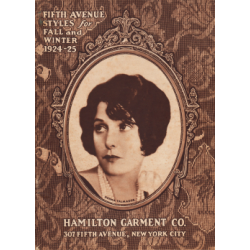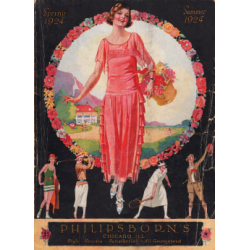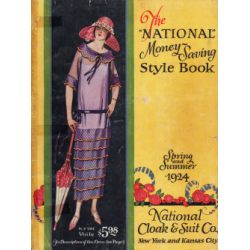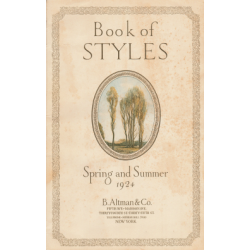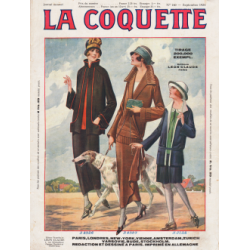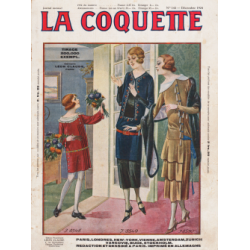Fashion 1924
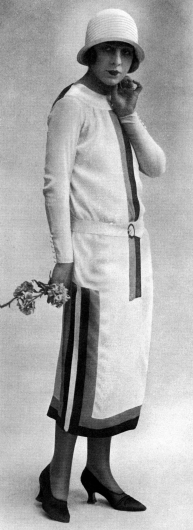 Afternoon dress by the fashion house Welly Soeurs in white crepe de chine with green and black trim whose vertical workmanship emphasizes the straight line — Les Modes, no. 238 (24), March 1924, p. 23. Photo: Henri Manuel, Paris (1874-1947).
Afternoon dress by the fashion house Welly Soeurs in white crepe de chine with green and black trim whose vertical workmanship emphasizes the straight line — Les Modes, no. 238 (24), March 1924, p. 23. Photo: Henri Manuel, Paris (1874-1947).
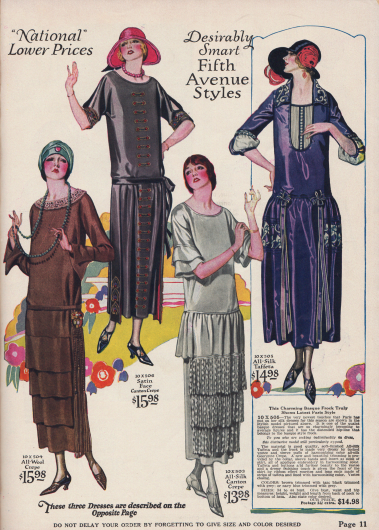 Dresses in straight line and a robe de style made of wool-, satin- and silk crepe fabrics and silk taffeta
—
National Cloak & Suit Co. Spring/Summer 1924, p. 11
Dresses in straight line and a robe de style made of wool-, satin- and silk crepe fabrics and silk taffeta
—
National Cloak & Suit Co. Spring/Summer 1924, p. 11
 Women's coats with wide sleeves and a cloak, made of pure wool fabrics. Backs decorated with panel embroideries
—
Philipsborns Spring/Summer 1924, p. 85
Women's coats with wide sleeves and a cloak, made of pure wool fabrics. Backs decorated with panel embroideries
—
Philipsborns Spring/Summer 1924, p. 85
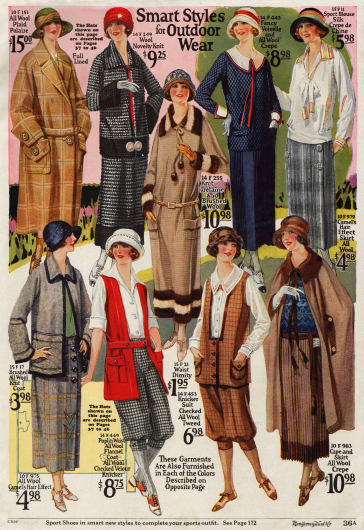 Ladies coat, cape, jackets, skirts and sporty suits with knickerbockers in wool fabrics — Montgomery Ward & Co., Spring/Summer 1924, p. 36A
Ladies coat, cape, jackets, skirts and sporty suits with knickerbockers in wool fabrics — Montgomery Ward & Co., Spring/Summer 1924, p. 36A
 Fur chokers, scarves and stoles from fox, opossum, rabbit, squirrel or mink
—
Hamilton Garment Co. Spring/Summer 1924, p. 78
Fur chokers, scarves and stoles from fox, opossum, rabbit, squirrel or mink
—
Hamilton Garment Co. Spring/Summer 1924, p. 78
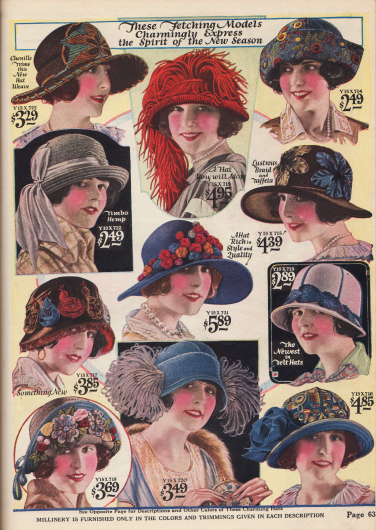 Hats with flowers and feather decorations
—
National Cloak & Suit Co. Spring/Summer 1924, p. 63
Hats with flowers and feather decorations
—
National Cloak & Suit Co. Spring/Summer 1924, p. 63
 Men's suits made of pure wool fabrics. Sporty style suit (left) and jazz suit on the far right
—
Philipsborns Spring/Summer 1924, p. 308
Men's suits made of pure wool fabrics. Sporty style suit (left) and jazz suit on the far right
—
Philipsborns Spring/Summer 1924, p. 308
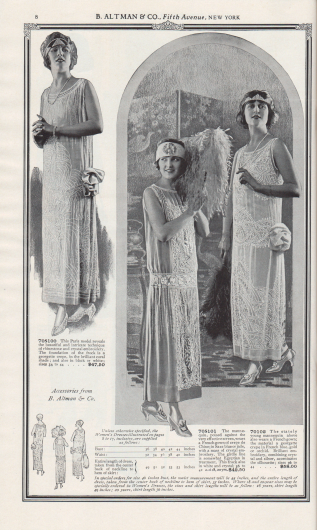 Evening gowns in Georgette crepe or crepe de chine with lavish rhinestone and pearl embroidery
—
B. Altman & Co. Spring/Summer 1924, p. 8
Evening gowns in Georgette crepe or crepe de chine with lavish rhinestone and pearl embroidery
—
B. Altman & Co. Spring/Summer 1924, p. 8
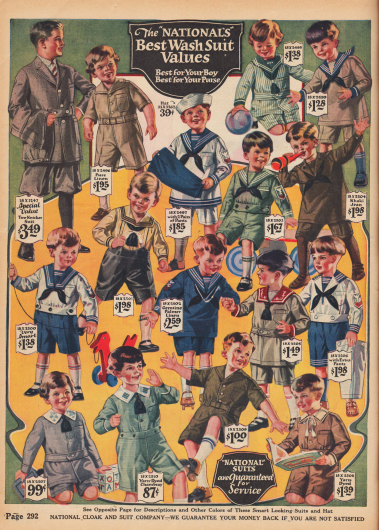 Playsuits of cotton and linen fabrics for boys from 3 to 8 years
—
National Cloak & Suit Co. Spring/Summer 1924, p. 292
Playsuits of cotton and linen fabrics for boys from 3 to 8 years
—
National Cloak & Suit Co. Spring/Summer 1924, p. 292
In women's fashion a straight and slim line crystallizes in 1924. This year, the narrow, tight skirt increasingly replaces the wide, draped skirt of last year. The quite close-fitting, almost tube-like dress, the so-called sheath dress, becomes a favourite of spring fashion. This straight silhouette is interrupted in some dresses only by a wide flounce, e.g. made of pleated fabric, which starts at the knee at the earliest and expands the hem bell-shaped or flares out when walking. Simplicity and straightforward dress cuts give this year's fashion an extremely sporty and youthful touch.
Last year's ankle-length skirt is also outdated and this spring it is already several centimetres shorter. By the end of the year, the hem of the skirt reaches the calf again. The waistline remains very low at hip height, with many dresses not even being worn with a belt as this has gone somewhat out of fashion.
Smock Blouse and Chemise Dress
The lady's street suit in spring, which should appear as casual and sporty as possible, consists of a short jacket, a skirt and a smock blouse. The smock blouse, a very long blouse, which is usually worn with a belt and actually comes from sports fashion, replaces the blouse this year. The blouse is worn over the skirt and sometimes it is so long that the blouse looks like a dress and the skirt often only sticks out a few centimetres below it. Often, under a long blouse, only an undershirt with a sewn-on skirt is worn, which consists of only one strip of fabric. Rips, flannel, alpaca and tricot fabric are perfect for this long blouse, which of course should be color-coordinated with the rest of the costume. If the jacket and skirt are one color, the tunic can be chosen in bright colors or fabric patterns. If the jacket and skirt are made of striped, checked or Scotch tartan fabric, a light-colored, plain smock blouse should be chosen.
The dress presents itself in 1924 in a simple cut. The lines are very similar to those of a shirt or chemise and fall straight down from the shoulder. The chemise dresses, which only appear simple at first glance, get their special charm from fine but elaborate details, which should be as discreet as possible. Laborious handicrafts, quilting, hand and machine embroidery, incorporated apron parts, borders and appliqués made of fabric panels give each dress its own character. The embroideries as well as the patterns of the dress fabrics run mainly crosswise.
Short Sleeves, Scarves and Color Red Fashionable
Especially in spring and summer many dresses show short sleeves. Afternoon dresses for warm days, on the other hand, are sleeveless throughout. Preferred colours this year are brown in all shades, light grey tones or beige. These colours are often combined with this year's fashion colour red, which appears in all shades. Especially geranium, sealing wax and tomato red are the most popular and are used to great effect - mainly for hats, scarves or tunics.
This year, the scarf, which is already extremely popular at the beginning of the year and has become an important accessory in fashion, is taking on special significance. The German magazine Die Dame notes in its first December issue that "[e]very second dress today has a scarf, a tie or a bow. It has to be something fluttering."1 Large bows are tied from a very long, or even two-coloured scarf, which can be made of chiffon, for example, with the ends falling down to the knee. Ties are passed through the fabric of the dress and are sometimes so grotesquely long that they reach down to the hem of the dress. A similar effect is achieved by bands and jabots, which are reminiscent of the Directoire era. Some dresses do not have a collar at all, but instead have a cut-on scarf. In summer, the scarf is increasingly replaced by a colorful shawl.
Small Hat Favourite
Small hats with extremely narrow, short brims remain very popular with the ladies. A pair of these small hats in cylindrical form show short, but also high head shapes, whereas hats in bell shape usually fit extremely tight and close to the head. Pedal and picot straw, tulle, panne straw, felt and velvet are the most commonly used materials for hats. Ribbons in all widths and colors, blossoms, bows, rosettes, variegated stitching, hat pins and even frills and buttons made of metal or mother-of-pearl are used to garnish the otherwise simple hats. Japanese influence can be seen in the design or in hat trimmings in red lacquer. In the summer months, the very large hat with its extra-wide brim conquers its place in fashion. Especially these summer hats present delicate aigrette feathers, ribbons and flowers, which also extend beyond the wide brim.
Autumn Fashion Shows Few Innovations
The two and three-piece costume, also known as ensemble or complete, gained increasing importance in the autumn fashion of 1924. The two-piece suit consisting of dress and coat is undoubtedly more elegant than the three-piece suit consisting of tunic, skirt and coat, which looks much more sporty and thus casual. Characteristic of the autumnal line is the retention of the straight, tube-like line of dress and coat, whereby even first dresses with bell-shaped skirts point in a new direction of fashion. The fashion fabric of autumn is ribbed silk (ottoman) next to artificial silk and velvet. Slight echoes of the Directoire and Empire epochs and Chinese influences, which are expressed in embroidery as well as small Chinese curls or open pagoda sleeves, are noticeable.
Directoire Coat, Paletot and Fur Coat
The fondness for early 19th century fashion is particularly noticeable in jabots, high-necked collars and the double-breasted Directoire coat, whose lapels and collars are particularly sweepingly shaped and can be trimmed with fur. Coats with coachman's pelerine have similar echoes. In contrast, the male paletot made of English fabric, which is preferably worn in the mornings, has a simple appearance with a light waist, flap pockets and a black velvet collar. The Paletot goes best with men's shirt and coat dresses with tie and leather belt. Rich fur trimmings of leopard, rabbit, shorn lamb, chinchilla, gazelle, monkey or goat, on the other hand, can be seen on the other autumn coats. Persian lamb or astrakhan, broadtail, ermine and mink are the predominant species for fur coats.
Luxurious Evening Wear
Evening dresses cannot be elaborate and luxurious enough. Expensive and noble fabrics such as coloured brocades, silk, lace fabrics, chiffon, gold and silver lamé as well as sparkling rhinestone or pearl ornaments or silk embroidery enrich the dresses, which are so simple on average and resemble a gown or bodice in their shape. A long, looped tulle scarf is not dispensed with here either. The evening dresses are almost without exception sleeveless. As a suitable headdress for the evening party, tiaras are the most sought-after ones, which are decorated with rhinestones, sparkling glass stones and, more rarely, with more precious stones. Bandeaux in the Empire style or with ribbons falling down to the sides, headdress made of galalith, turbans made of gold fabric and nets made of pearls and coloured stones with chains hanging down decorate the heads of the elegant ladies. But also headbands with embroideries or fabric flowers are very popular.
A special change to the shapeless, straight dress form is offered to the lady who prefers a feminine silhouette by the robe de style. This dress is characterized by a wide flared basque skirt from hip to hem, while the bodice of the dress is kept in the straight line of the current fashion. This stylish dress is especially popular for evening occasions. But also as an afternoon dress the dress finds followers and is worn in the summer months preferably with a wide-brimmed hat.
Children's Clothing
Children's fashion is very similar to the fashion of the grown-ups. Especially the dresses and gowns for little girls show, like their big idols, the low waistlines and the shapeless and beltless line. Button plackets, turn-ups and bows are copied from the ladies' dresses. Chequered fabrics for dresses and coats are just as common as crocheted and knitted dresses and suits for all ages.
For boys, washable play suits made of khaki, denim or batiste are offered in US mail order catalogues. Many of these playsuits are based on military or police uniforms and baseball or Indian playsuits are also popular. Especially popular in the United States, as well as in Europe and the German Reich, are navy and sailor suits for little boys. Boys usually get their first long-legged trousers at about 10 years of age when a suit is bought for a special occasion. Up to this age, but also beyond, boys wear suits with short trousers that are worn with knee socks.
Mail Order Business in Transition
At the beginning of the twenties, the fashion of the American mail order companies is still very up to date and picks up current trends promptly. The catalogues offer a huge selection of different clothes in all variations.
In the mid-twenties, however, US mail order companies increasingly began to compete with shops and department stores in small American cities. The main target group of the mail order companies, the farmers and rural population in the remote regions of the USA, can - favoured by mass production and increasing prosperity - afford increasingly affordable cars. As a reaction to changing consumer behaviour, large mail order companies such as Sears and Montgomery Ward established their own retail chains in small and large cities from 1925 onwards, reducing the range of products in their catalogues in order to be able to compete on price. The topicality of the fashion offered falls behind that of haute couture. Thus, current trends are only reflected in the catalogues after they have become generally accepted, with a time lag.
Mode aus Katalogen und Zeitschriften des Jahres 1924
Footnotes
1 Original German quote: "Jedes zweite Kleid hat heute einen Schal, eine Krawatte oder eine Schleife. Irgendetwas Flatterndes muss es sein," N. N., text without title, in: Die Dame, no. 6 (52), First December Issue 1924, p. 21.




